TREMAYNE: Verstappen wrapped up the title at last year’s race – but two other champions were also crowned in Las Vegas
Formula 1 Hall of Fame journalist David Tremayne takes a look back at the first incarnation of a Grand Prix run in Las Vegas, back in the early 1980s...


Sometimes you need something badly enough that you’ll put up with anything to make it happen. Even if it means that you end up having to race in a car park. Ask Bernie Ecclestone...
There used to be a place outside Las Vegas called the Stardust Raceway, but it was paved over in 1970 and in any case, by 1981, wasn’t close enough to the great gambling metropolis in the Nevada desert.
So that was how, when then F1-boss Bernie Ecclestone was looking for a new F1 venue, the two US Grands Prix run at the famed Caesars Palace (note the conscious deletion of the possessive apostrophe) in 1981 and ’82 came to be run where the punters usually left their cars.
Assuredly, that first event wasn’t what everyone had envisaged when the news was first announced.
The Caesars Palace GP should have been the perfect way to bring F1 to the people, at a time when F1 had just lost Watkins Glen, the sport’s longtime American home situated in New York State’s beautiful Finger Lakes region.
Sure, there was still Long Beach, over the other side of the country, with its dubious downtown attractions, but Detroit was another year away. And Bernie did not want F1 to lose its hold in its biggest market, especially at a time when Indycars and NASCAR were at their peaks.
Many F1 people were shocked – read appalled in most cases – to discover when they arrived that the 2.26-mile concrete-walled ‘track’ resembled, as John Watson put it, “three paper clips side by side” in the car park of the eponymous hotel/gambling emporium. But it was flat, its surface was smooth and it was actually quite quick.
And – wouldn’t you know it? – Bernie hit the jackpot even before any of the 30 cars turned a wheel.
He was dealt the perfect hand of cards as the strong 15-race season had boiled down to a shootout for the World Championship between points leader Carlos Reutemann of Williams and Nelson Piquet of Brabham (Bernie’s own man).
Carlos had 49 points, Nelson 48. Would the former be Argentina’s first World Champion since the great Juan Manuel Fangio? Or would the latter be Brazil’s first since trailblazer Emerson Fittipaldi?

Typically, Bernie’s hand included a wild card. Gentleman Jacques Laffite, on 43 points, could become France’s first champion but really needed to win with Nelson no higher than third and Carlos no higher than fourth.
But just to spice things further, if he won with Nelson third and Carlos fourth, each would have 52 points. But Jacques would rule with three wins (the same as Nelson) but two seconds to his single one.
In Friday practice, Carlos was in that absolutely imperious form he could produce every so often, lapping 0.415s faster than anyone else. And he casually pointed out that he had lost time on oil. But team mate Alan Jones got things to his liking on Saturday to join him on the front row.
Gilles Villeneuve showed his rodeo skills by taking his ill-handling Ferrari 126CK to third, from Nelson. The top 10 was completed by Alain Prost’s Renault; Watson’s McLaren; Patrick Tambay’s Ligier Matra; Bruno Giacomelli’s Alfa Romeo; Nigel Mansell’s Lotus; and national hero Mario Andretti in the other Alfa.

As one might have expected given the location, race day was dry and very hot, with an ambient temperature of 75 degrees Fahrenheit as the grid formed for the 75-lap event. And Carlos was about to suffer what looked like one of F1’s greatest bouts of stage fright.
He had missed the drivers’ briefing and now sat in the cockpit complaining to Frank Williams that having been fine in the morning warm-up, his FW07C had suddenly developed understeer from nowhere in right-handers on the formation laps.
On what should have been the crowning day of his career, Miserable Carlos had shoved Majestic Carlos aside.
Jones dominated the race from start to finish, ensuring that whatever happened, Williams secured the Constructors’ Championship. Gilles was his closest opposition until intolerant Clerk of the Course Bob Swenson exercised his own interesting brand of race promotion by disqualifying him failing to line up perfectly in his grid slot. The spectators loved that…

Carlos had begun his slump on the first lap, dropping from that stunning pole to sixth, and then Jacques also passed him. But Nelson had also lagged, and fallen to eighth on the first lap. But that was only temporary and by Lap 17 he overtook his fading rival, who curiously offered absolutely no resistance.
Nelson then came up trumps as he climbed to fifth, while Carlos continued to throw snake eyes, never looking like the man who had taken pole in such dominant fashion just the day before.
But as the race progressed, Nelson was in trouble. He was never the fittest driver, but he had also had a particularly harsh massage earlier in the week which hurt his back, and was now struggling badly. Perhaps the cards were falling for Carlos after all?
One more lap, and he would surely have caught and passed the Brabham, even at his strangely feeble pace. Nelson was completely done and had been sick in his helmet, and limped home fifth behind Jones, Prost, Giacomelli and Nigel Mansell, chased by Jacques, Wattie and Carlos.

He had scored those crucial two points, but had to be helped from the cockpit and it took him 15 minutes to make it to the podium. But he had done enough, he was World Champion for the first time.
And Carlos? When he had been leading the fight by a country mile at Silverstone (with 43 points to Nelson’s 26) he had effectively said to journalist Alan Henry that he doubted he would win the title. Now it had finished as 50 to 49. So what had happened? Why was his best race lap 1.3s off Jonesy’s?
Carlos himself never offered an explanation. Williams confirmed the corner weights and the gearbox were okay. They were completely bemused. Years later an Argentine journalist asked Carlos what on earth had happened.
“When I look back and recall that as a kid I had to go to school on horseback, and I went all the way from there to being an F1 driver… it is a pleasure that nobody can take away.”

It was an elegant response, but did nothing to solve the mystery. On his day of destiny a charismatic, complex character had simply become The Man Who Defeated Himself.
There would be another race in 1982, by which time Detroit had been added to Long Beach. The 16th round of the 1982 World Championship was scheduled to be run over 75 more laps on Saturday, October 16.
And… of course you guessed it: Bernie hit the jackpot again as it was another title decider, this time between Williams’ Keke Rosberg and McLaren’s John Watson, but the permutations were less clear-cut.
Keke had 42 points and needed only one to put the title beyond dispute if John, with 33, finished second or lower. Didier Pironi had 39, but his accident at Hockenheim in July had hospitalised him and he was out of racing.

The Ulsterman needed to win, with the Finn seventh or lower. That would have put both on 42, but Wattie would have had three wins to Keke’s one.
The Constructors’ title, meanwhile, was a three-horse race for the first time since 1964. Ferrari had 74 points to McLaren’s 63 and Renault’s 59.
Renault stitched up the front row courtesy of Alain Prost and Rene Arnoux. Michele Alboreto’s Tyrrell 011 was the first non-turbo in third ahead of Eddie Cheever’s Ligier Matra.
Riccardo Patrese’s Brabham BMW; Keke’s atmo Williams; Mario Andretti and Patrick Tambay in their Ferraris; Wattie’s McLaren; and Derek Warwick’s Toleman completed the top 10. Patrick wouldn’t start as he was unwell on raceday.

Alain and Rene battled for the lead until their Michelins started picking up marbles and then both ran into engine trouble. After surviving a hefty brush with Eddie on the opening lap, Michele began closing on the yellow cars.
Meanwhile, Wattie was into a strong comeback drive after falling to 12th initially, catching and passing Nelson’s Brabham-BMW on Lap 12, then went by Keke, Mario and Eddie in successive laps to climb to third behind Alain and Michele. When Mario’s Ferrari broke its rear suspension on Lap 17, Keke moved into the fifth place he needed.
As Alain’s Renault faded, Michele exploited Tyrrell’s gamble on soft Goodyear tyres to take the lead on Lap 52. Wattie demoted Alain on 56, Eddie another 10 laps later.
And so Michele went on to score his first Grand Prix victory and Uncle Ken’s first since Patrick Depailler in Monaco in 1978. He was the 11th different winner that extraordinary season, and took fastest lap to boot.

Behind Wattie and Eddie, Alain struggled to fourth and Keke led team mate Derek Daly home in fifth and sixth, the Finn becoming the first from his country to be crowned World Champion. Despite their woes, Ferrari took the Constructors’ honours.
The victory icing on Tyrrell’s cake. During Uncle Ken’s joyful post-race leap he waved a blue slip of paper. On Friday he had taken advantage of unwise odds of 20 to 1 on a Tyrrell victory, and having put down $100 he was well rewarded by his driver’s performance. The blue paper was his betting slip…
So ended the adventure at Caesars Palace. It marked the first time since the Formula 1 World Championship had been inaugurated in 1950 that any country had staged three races in the same season – and the last until 2023 when, with Austin and Miami’s Grands Prix, racing once again returned to Nevada, albeit on a very different track in the very heart of ‘The Entertainment Capital of the World'.
Next Up
Related Articles
 HighlightsWatch FP1 highlights in Las Vegas as Leclerc goes fastest
HighlightsWatch FP1 highlights in Las Vegas as Leclerc goes fastest Russell reflects on Las Vegas hopes one year on from victory
Russell reflects on Las Vegas hopes one year on from victory Practice DebriefA four-way scrap for the winnings in Las Vegas?
Practice DebriefA four-way scrap for the winnings in Las Vegas?.webp) Paddock InsiderLas Vegas sets the stage for the 2025 F1 title run-in
Paddock InsiderLas Vegas sets the stage for the 2025 F1 title run-in F1 AcademyGatorade to support Lisa Billard for 2026 F1 ACADEMY season
F1 AcademyGatorade to support Lisa Billard for 2026 F1 ACADEMY season Norris hails 'better than ever' relationship with Piastri
Norris hails 'better than ever' relationship with Piastri